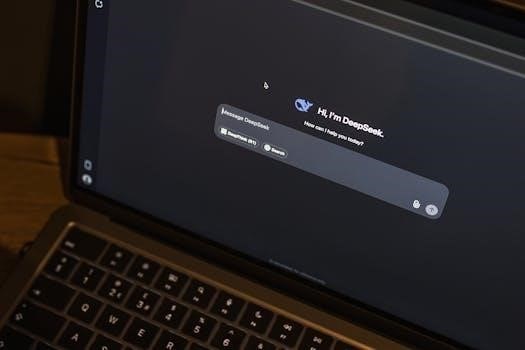ChatGPT Prompts for Payroll Managers⁚ A Comprehensive Guide
Unlock the potential of ChatGPT for payroll management with this comprehensive guide, designed to streamline operations and reduce errors. This resource provides payroll managers with specialized prompts to improve automation, ensure tax compliance, and optimize compensation strategies in today’s dynamic business environment, and get a cheat sheet.
In today’s rapidly evolving business landscape, payroll managers face the constant challenge of ensuring accurate and timely salary disbursements, managing deductions, and administering benefits. The integration of artificial intelligence, specifically ChatGPT, offers a transformative approach to streamline these intricate processes.
ChatGPT, with its ability to understand and generate human-like responses, is revolutionizing various aspects of HR, including payroll. This guide explores how payroll professionals can leverage ChatGPT to enhance productivity, minimize errors, and navigate the complexities of modern payroll management. By utilizing carefully crafted prompts, payroll managers can automate repetitive tasks, improve compliance, and address employee queries efficiently.
This introduction sets the stage for a deeper dive into practical ChatGPT prompts tailored for payroll functions, offering a pathway to a more efficient and accurate payroll management system. As ChatGPT makes waves due to its increasing ability to understand and generate human-like responses, I couldnt help but push the envelope.
Benefits of Using ChatGPT in Payroll
Integrating ChatGPT into payroll processes offers numerous advantages, primarily centered around enhanced efficiency and accuracy; By automating routine tasks, ChatGPT frees up payroll professionals to focus on more strategic initiatives. This includes generating monthly payroll reports, providing summaries of wages, deductions, and net payments with remarkable speed and precision.
Moreover, ChatGPT aids in maintaining compliance with ever-changing regulations. It can generate compliance checklists tailored to specific state and industry laws, including updates for the year 2025 related to wages and paid leave, ensuring adherence to the latest legal standards.

ChatGPT also excels in handling employee queries, providing quick and consistent answers to common questions regarding paychecks, deductions, and tax-related matters. This reduces the burden on HR staff and enhances employee satisfaction. Ultimately, leveraging ChatGPT in payroll leads to significant time savings, reduced error rates, and improved overall operational efficiency.
Generating Payroll Reports with ChatGPT
ChatGPT can significantly streamline the creation of payroll reports, transforming a time-consuming task into a swift and efficient process. By utilizing specific prompts, payroll managers can instruct ChatGPT to compile comprehensive reports that include essential data points, such as total wages, deductions, and net payments. These reports can be broken down by department, employee, or any other desired category, providing granular insights into payroll expenditures.
Furthermore, ChatGPT can be used to generate summaries of monthly payroll activities, highlighting key trends and anomalies. This allows payroll managers to quickly identify potential issues and address them proactively. The AI can also format the reports in various styles, ensuring they are easy to read and understand. By automating the report generation process, ChatGPT reduces the risk of manual errors and frees up payroll staff to focus on more strategic tasks, such as analyzing payroll data and developing compensation strategies.
ChatGPT Prompts for Monthly Payroll Summaries
Creating monthly payroll summaries is a crucial task for payroll managers, and ChatGPT can significantly enhance this process. Effective prompts can instruct ChatGPT to generate detailed summaries encompassing total wages, deductions, and net payments for the month. These summaries can be further refined by specifying breakdowns based on departments, employee categories, or other relevant criteria, offering a comprehensive overview of payroll activities.
For instance, a prompt like “Create a summary of this month’s payroll, including total wages, deductions, and net payments, broken down by department” can yield a well-organized report. Additionally, ChatGPT can be prompted to highlight any significant variances from previous months, aiding in the identification of potential discrepancies or trends that require investigation. This level of detail ensures accurate financial reporting and supports informed decision-making regarding payroll management.
ChatGPT Prompts for Compliance Checklists
Ensuring compliance with ever-changing employment laws and regulations is a paramount responsibility for payroll managers. ChatGPT can be a valuable tool in creating comprehensive compliance checklists, which help to systematically verify adherence to legal requirements. Effective prompts can instruct ChatGPT to generate checklists tailored to specific state or industry regulations, encompassing key areas such as wage laws, paid leave policies, and tax requirements.
For example, a prompt like “Generate a compliance checklist for state-specific employment laws related to wages and paid leave” can produce a detailed list of essential checks. Furthermore, ChatGPT can be prompted to incorporate recent legislative changes and updates, ensuring that the checklist remains current and accurate. By using these AI-powered checklists, payroll managers can proactively identify and address potential compliance gaps, mitigating the risk of costly penalties and legal issues while improving HR mundane tasks.
Specific Prompts for Wage-Related Compliance (2025)
Wage-related compliance is a critical area for payroll managers, particularly with the constant evolution of labor laws. To ensure adherence in 2025, it’s essential to use specific ChatGPT prompts that address the latest regulatory changes. These prompts should focus on key aspects such as minimum wage adjustments, overtime pay calculations, and rules concerning deductions from employee wages. For instance, a prompt like, “Outline the updated regulations for minimum wage and overtime pay in [specific state] for 2025,” can provide a detailed overview of the current requirements.
Furthermore, prompts should address emerging compliance areas such as pay equity laws and transparency requirements; By crafting prompts that directly target these specific wage-related issues, payroll managers can leverage ChatGPT to create comprehensive compliance strategies, update internal policies, and train staff on the latest legal standards. Proactive use of these tools helps mitigate compliance risks and ensures fair and accurate wage practices.
ChatGPT for Streamlining HR Processes
ChatGPT offers significant potential for streamlining various HR processes, extending beyond just payroll management. By utilizing AI-driven automation, HR professionals can optimize numerous tasks, from onboarding new team members to managing employee engagement. For example, ChatGPT can assist in creating checklists and workflows for hiring and onboarding, ensuring that all necessary steps are followed consistently and efficiently. It can also be used to generate templates for performance reviews, saving time and ensuring comprehensive feedback.
Moreover, ChatGPT can enhance communication within the HR department by providing quick support and navigating the intricacies of administrative tasks. It can help draft internal memos, update employee handbooks, and even assist in scheduling meetings and training sessions. By automating these routine tasks, HR staff can focus on more strategic initiatives, such as employee development and talent acquisition, ultimately improving overall organizational effectiveness. Integrating ChatGPT into HR workflows leads to quicker turnaround times and reduced administrative burdens.
ChatGPT Prompts for Employee Queries
ChatGPT can significantly enhance HR’s ability to handle employee queries efficiently and accurately. By using tailored prompts, HR can leverage ChatGPT to provide instant answers to common questions, reducing the workload on HR staff and improving employee satisfaction. For instance, prompts can be designed to address questions related to company policies, benefits packages, and payroll procedures. Employees can receive immediate clarification on topics like vacation time accrual, health insurance coverage, and expense reimbursement processes.
Furthermore, ChatGPT can be used to create a self-service knowledge base where employees can find answers to frequently asked questions without needing to contact HR directly. This not only saves time for both employees and HR but also ensures consistent and accurate information dissemination. Prompts can be designed to address questions about career development opportunities, training programs, and internal job postings. By providing quick and accessible information, ChatGPT empowers employees to take ownership of their career growth and fosters a more informed and engaged workforce.
ChatGPT Prompts for Tax Matters
Navigating the complexities of tax regulations can be challenging for payroll managers. ChatGPT can be a valuable tool for staying compliant and accurate. Utilize prompts to generate explanations of tax laws and updates relevant to payroll, ensuring your organization adheres to the latest regulations. Create prompts that ask for summaries of changes in tax legislation affecting payroll deductions, employer contributions, and reporting requirements. This helps maintain compliance and avoid potential penalties.

Moreover, ChatGPT can assist in generating reports and documentation required for tax filings. Prompts can be crafted to create summaries of employee earnings, deductions, and taxes withheld for specific periods. This streamlines the preparation of W-2s, 1099s, and other tax-related forms. Additionally, use ChatGPT to create checklists and reminders for important tax deadlines, ensuring timely filing and preventing late fees. By leveraging ChatGPT for tax matters, payroll managers can enhance accuracy, efficiency, and compliance in their tax-related responsibilities.
ChatGPT Prompts for Salary Calculations
Accurate salary calculations are the cornerstone of effective payroll management. ChatGPT can assist in automating and refining these calculations, ensuring precision and efficiency. Develop prompts to calculate gross pay, taking into account hourly rates, overtime, bonuses, and commissions. This streamlines the payroll process and minimizes manual errors. Further, utilize prompts to compute deductions for taxes, insurance, retirement contributions, and other withholdings, adhering to legal and company policies.
ChatGPT can also aid in calculating net pay and generating pay stubs that clearly outline earnings and deductions. Craft prompts to create customizable pay stub templates that comply with regulatory requirements. Additionally, leverage ChatGPT to handle complex salary calculations, such as those involving retroactive pay, shift differentials, or garnishments. By using targeted prompts for salary calculations, payroll managers can enhance accuracy, save time, and ensure employees are compensated correctly and on time. This leads to increased employee satisfaction and reduced payroll-related discrepancies.
Crafting Job Descriptions with ChatGPT

Creating effective job descriptions is crucial for attracting top talent. ChatGPT can significantly streamline this process by generating engaging and informative job descriptions tailored to specific roles. Begin by crafting prompts that outline the key responsibilities, required skills, and desired qualifications for a particular position. Specify the job title, department, and reporting structure to ensure accuracy and relevance. Use prompts to emphasize the company culture and growth potential, making the job description more appealing to prospective candidates.

ChatGPT can also assist in developing concise and clear descriptions that highlight the unique aspects of the position. Generate prompts that focus on the day-to-day tasks, essential functions, and performance expectations. Furthermore, leverage ChatGPT to incorporate relevant keywords that improve search engine optimization, increasing the visibility of the job posting. Ensure the job description complies with legal requirements and company policies. By using ChatGPT, HR professionals can efficiently create compelling job descriptions that attract qualified applicants and accurately represent the role within the organization. This saves time and resources in the recruitment process.
Using ChatGPT for Stay Interviews and Retention
Stay interviews are a proactive approach to employee retention, aiming to understand what keeps employees engaged and satisfied in their roles. ChatGPT can be a valuable tool in preparing for and analyzing stay interviews. Begin by using ChatGPT to generate a list of insightful questions to ask during stay interviews. These questions should explore topics such as job satisfaction, career development opportunities, work-life balance, and potential areas for improvement. Tailor the prompts to specific employee roles and departments to ensure relevance and depth.
ChatGPT can also help in summarizing and analyzing the feedback gathered during stay interviews. Input the interview notes into ChatGPT and prompt it to identify recurring themes, concerns, and suggestions for improvement. Use these insights to develop targeted retention strategies that address the specific needs and preferences of employees. This proactive approach demonstrates a commitment to employee well-being and fosters a positive work environment. By leveraging ChatGPT for stay interviews, organizations can improve employee retention rates and maintain a motivated and engaged workforce.
Creating Action Plans Based on Stay Interview Insights
Once you’ve gathered insights from stay interviews using ChatGPT, the next step is to translate those insights into actionable plans. Start by prompting ChatGPT to formulate a comprehensive action plan based on the identified themes and concerns. This plan should outline specific steps to address employee needs, improve job satisfaction, and enhance retention.
For example, if employees express a desire for more career development opportunities, the action plan might include initiatives such as mentorship programs, training workshops, or tuition reimbursement. If work-life balance is a concern, the plan could propose flexible work arrangements or additional support for managing workloads. Ensure that each action item is assigned to a specific individual or team, with clear deadlines and measurable goals. Regularly review the progress of the action plan and adjust it as needed based on ongoing feedback and results. By creating and implementing effective action plans, organizations can demonstrate their commitment to employee well-being and create a positive work environment that fosters retention and engagement.

No Responses